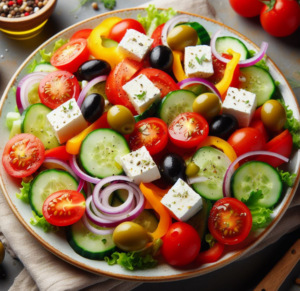 Greek cuisine boasts timeless appeal, with its combination of fresh flavors and centuries-old recipes handed down through generations. As diners become more adventurous and open to new culinary experiences, there has been a growing trend of adding contemporary touches to classic Greek dishes. This article delves into the novel approaches that chefs and home cooks alike are using to modernize traditional Greek recipes while maintaining the essence of this beloved Mediterranean cuisine.
Greek cuisine boasts timeless appeal, with its combination of fresh flavors and centuries-old recipes handed down through generations. As diners become more adventurous and open to new culinary experiences, there has been a growing trend of adding contemporary touches to classic Greek dishes. This article delves into the novel approaches that chefs and home cooks alike are using to modernize traditional Greek recipes while maintaining the essence of this beloved Mediterranean cuisine.
Reinventing the Greek salad involves a creative approach to a time-honored recipe that remains a beloved fixture of summer dining. This dish, which goes by ‘Horiatiki’ in Greece, captures the essence of Greek cuisine through its use of simple, fresh ingredients. The traditional Greek salad brings together ripe tomatoes, crisp cucumbers, sharp onions, green bell pepper, rich kalamata olives, and creamy feta cheese, all brought to life with a generous dressing of olive oil and oregano, with an occasional touch of vinegar.
The evolution of this salad reflects a balance between maintaining the integrity of the original and introducing novel flavors and textures. By incorporating heirloom tomato varieties, a richer and more diverse palate is invited. These tomatoes contribute a variety of colors that can transform the visual presentation of the dish.
Infused olive oils have become a popular way to add a new dimension to the salad. By gently warming olive oil with aromatic herbs like thyme or rosemary, a subtle yet distinct flavor is imparted, adding to the complexity of the dish. This type of infusion also introduces an element of craftsmanship that can be appreciated by both home cooks and restaurant chefs alike.
The introduction of unexpected ingredients serves to both surprise and delight the palate. For example, the inclusion of sweet elements such as watermelon or pomegranate seeds can produce a delightful contrast to the briny olives and robust feta. This interplay of sweet and salty flavors caters to the modern palate, which often seeks out these complex flavor combinations.
Chefs may also choose to add textural contrasts by incorporating microgreens or edible flowers into the presentation. These ingredients, while not detracting from the familiar flavor profile of the Greek salad, provide a layer of sophistication and a feast for the eyes, reaffirming that visual appeal is an integral part of the dining experience.
Embracing modern culinary trends, the Greek salad can be adapted for dietary preferences as well. Substituting dairy-free cheese alternatives allows for a vegan-friendly option without compromising the richness that feta contributes to the dish.
In modernizing the Greek salad, the key is to respect the harmony and balance of the original while finding ways to infuse creativity and contemporary tastes. The success of these innovations lies in their ability to enhance and complement the core components that have made the Greek salad a timeless classic. Through thoughtful reinvention, the Greek salad continues to be a vibrant representation of Greek culinary tradition with a fresh and modern twist.
Evolving the Moussaka Experience
000Evolving the moussaka experience goes beyond just altering ingredients; it encompasses redefining the dish to align with contemporary lifestyles and tastes. The traditional moussaka has stood as a testament to classic comfort food, with its delightful layers of sautéed eggplant, savory minced meat smothered in a rich tomato-based sauce, and crowned with a golden béchamel sauce, all baked to achieve the perfect balance of flavors and textures.
In the culinary world, professionals are adopting a spirit of innovation with this dish, making it accessible and appealing to a broader audience. One key transformation is the introduction of plant-based alternatives to the meat component. A savory lentil concoction simmers with the same aromatic herbs and spices, ensuring the essence of the dish remains intact while offering a substantial, meat-free option. Finely minced mushrooms can also step in as a formidable replacement for minced meat, maintaining a meaty texture without the actual use of animal products.
The béchamel sauce, a staple in creating that signature moussaka richness, is being reimagined to cater to a wider range of dietary needs. Low-fat milk options reduce calorie content, and for those avoiding dairy or adhering to a vegan lifestyle, plant-based milk varieties such as almond or soy milk present a suitable alternative without compromising the creamy indulgence of the sauce. This shift ensures the dish is inclusive for those with dietary restrictions.
Modern dining also favors individual presentation and the personal touch of unique plating. To keep pace with this trend, chefs are crafting moussaka stacks that retain all the classic flavors in a single-serving format, ideal for upscale dining scenarios or tapas-style menus. Utilizing ring molds, they artfully layer eggplant, protein alternatives, and béchamel to present an elegant and personalized eating experience.
A creative twist on the recipe includes integrating new elements like sweet potatoes or roasted red peppers, broadening the dish’s flavor profile. These ingredients contribute to an aesthetically pleasing plate.
The transformation of moussaka also involves deconstructing the traditional assembly for a more avant-garde presentation. By separating the layers and reimagining them on the plate, diners are treated to a visual feast that deconstructs familiar flavors in an unfamiliar presentation—encouraging a dialogue around the meal and deepening their appreciation for the intricate blend of tastes.
Through these culinary innovations, the moussaka experience is made more adaptable and alluring. These enhancements invite a new audience to enjoy a time-honored dish while providing long-time moussaka enthusiasts with a fresh take on their beloved classic. Such efforts reflect the dynamic nature of culinary arts, showcasing how traditional dishes can be transformed to reflect the evolving preferences of a diverse and modern clientele.
Spanakopita with a Gourmet Edge
 Spanakopita, the traditional Greek spinach and feta pie enveloped in phyllo pastry, stands as a timeless component of Greece’s culinary heritage. This dish, characterized by its flaky texture and rich flavors, has long been a crowd-pleaser, yet it remains open to reinvention for the modern palate. Culinary artists are injecting new life into this classic by enhancing the quality of the components and reinventing the dish’s presentation.
Spanakopita, the traditional Greek spinach and feta pie enveloped in phyllo pastry, stands as a timeless component of Greece’s culinary heritage. This dish, characterized by its flaky texture and rich flavors, has long been a crowd-pleaser, yet it remains open to reinvention for the modern palate. Culinary artists are injecting new life into this classic by enhancing the quality of the components and reinventing the dish’s presentation.
A popular innovation is to experiment with various cheeses, complementing or substituting feta with options like creamy ricotta or tangy goat cheese. These cheeses blend harmoniously with the spinach, layering the filling with complex tastes and a more decadent mouthfeel. Elevating the flavor profile further, the integration of fresh herbs such as dill and mint, as well as an occasional grating of lemon zest, can inject a zesty freshness, uplifting the traditionally hearty flavor notes.
As for presentation, spanakopita is morphing into new forms to suit different settings and dining experiences. Traditional pie shapes and triangular servings are giving way to intriguing spirals and even small, elegant tartlets that are perfect for upscale catering or personalized dinner gatherings. These innovative shapes make the dish more versatile, catering to a wide array of events and preferences.
Phyllo dough is under renovation as well, with some cooks using alternative variations such as whole wheat or gluten-free options, thus extending the dish’s reach to those with specific dietary choices or restrictions. These adaptations ensure that the essential element of spanakopita—the delightfully crispy phyllo—remains a constant in this evolving recipe.
The adaptation of Greek culinary classics like spanakopita highlights the delicate art of respecting traditional recipes while also exploring new culinary horizons. By thoughtfully integrating contemporary touches in ingredients, cooking methods, and aesthetics, chefs allow Greek gastronomy to persist in its appeal to a global audience, enticing those who seek both the comfort of the familiar and the excitement of the new. The introduction of refined salads, reinvented stews, and sophisticated pastry modifications exemplifies how Greek cuisine maintains its relevance, continually energized by a spirit of innovation. This dynamism ensures the ongoing significance and enjoyment of Greek dishes within the broad spectrum of world cuisine.
